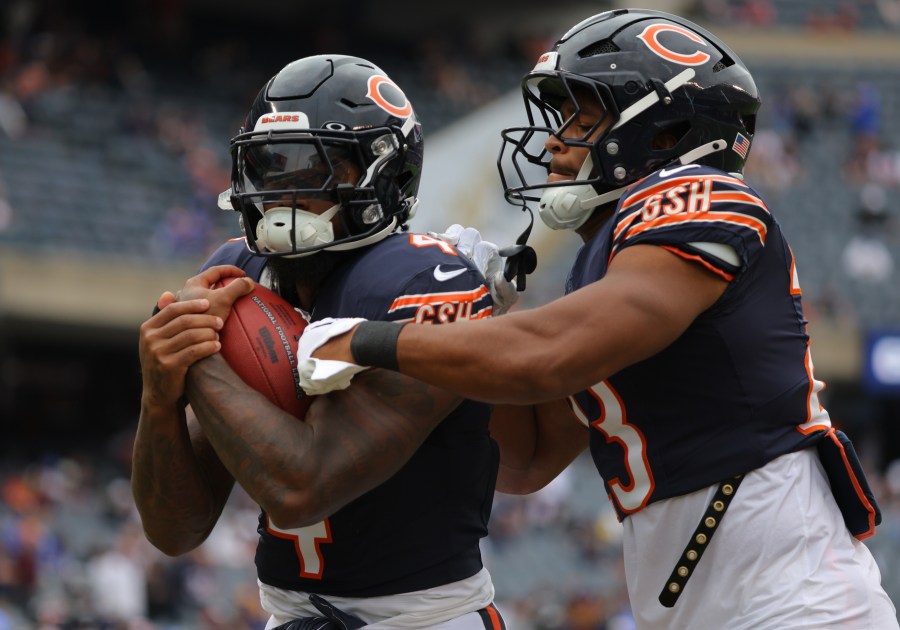CHICAGO (WGN) — If D’Andre Swift was the lightning, Roschon Johnson was the thunder, and if the Chicago Bears offensive line ever figures out how to look more formidable than a pack of wet noodles, they may have the makings of a formidable 1-2 punch after their Week 4 showing against the Los Angeles Rams.
It’s a dynamic indicative of running a successful offense in the NFL — having two running backs where one is the sledgehammer, and the other is the sword.
The Baltimore Ravens have Derrick Henry and Justice Hill. The Detroit Lions have David Montgomery and Jahmyr Gibbs. When Tom Brady was winning Super Bowls with the New England Patriots, he had Corey Dillon and Kevin Faulk. LeGarrette Blount and Dion Lewis. Sony Michel and James White. The examples go on.
The point is, whether it’s the Super Bowl contenders of today or the winners of the past, the formula for offensive success often depends on whether a team has their Batman and Robbin of the backfield established behind their quarterback.
After shrugging off a sluggish first quarter-and-a-half of football Sunday, that one-two punch for the Bears seemed to be Roschon Johnson (the sledgehammer) and D’Andre Swift (the sword).
As it goes in most cases of combat, the bashing and bruising blunt object often softens up the opposition before the swifter, more agile tool is brought in to slice through the competition and deliver the killing blow.
After a pass interference penalty on 3rd and 9 in the red zone lined the Bears up at the Rams’ 1-yard line, Chicago lined up in the I-formation and handed Johnson the ball. The Texas alum squared all 225 pounds of his frame toward the B-gap and bulldozed his way into the end zone for the Bears’ first offensive touchdown of the afternoon.
Johnson finished the day with a paltry 7 carries for 26 yards to go with that 1-yard touchdown, but he played his role well — the sledgehammer in short-yardage situations.
As the game went on, Chicago pivoted from hammer to sword and back, tactfully delivering smashing blows, mixed in with slashing cuts.
First, it was a 27-yard pass to Swift that saw him dance his way to the Los Angeles 32-yard line just before the end of the first half. Then mid-way through the third, it was 9 and 11-yard gains from Swift, followed by a bruising 8 yards from Johnson on a run straight up the gut.
Then came the killing blow. With just a hair more than 12 minutes left in the ballgame, Swift made one cut, a leap, and turned on the jets for the final touchdown scored Sunday at Soldier Field — a 36-yard scamper into the end zone.
Sure, Caleb Williams turned a clean sheet into the turnover department and faced down pressure better than he has to this point in his rookie season.
By the end of Sunday’s slate of NFL games, Williams registered a 124.5 passer rating when under pressure, the highest of anyone deemed a quarterback so far in Week 4 (there are two Monday night matchups yet to play).
The defense was also as advertised. If Montez Sweat doesn’t force a strip sack on Matthew Stafford, or Jaquan Brisker doesn’t pick him off with just under a minute to go, the direction of this column may be completely different.
But it isn’t, and driving home the yin-yang importance of Johnson and Swift continues.
The Bears top two running backs proved they could function formidably against the Rams, but the deciding factor of what will ultimately allow them to sink or swim rests with what dictates the success of every other component of the offense.
Chicago’s offensive line.
At near the halfway point of the second quarter Sunday, the Bears had accumulated seven penalties for 60 yards, 40 yards of which came from penalties on DJ Moore (illegal formation), Braxton Jones (illegal blindside block), Darnell Wright (false start) and Coleman Shelton (holding).
For about 23 minutes, those who were supposed to be road graters looked more like dancers with two left feet, or a band of blindfolded bulls in a china shop, and Chicago’s offense punted on three straight possessions to start the game because of it.
As if matters early on along the offensive line couldn’t be much worse, all those penalties came on top of Teven Jenkins, arguably the Bears’ top offensive lineman, leaving the game with a rib injury.
Fortunately enough, the offensive line wrangled in the penalties and the run game became more functional as the game went on, but Chicago will still need more complete performances from their men in the trenches if they are to develop a meaningful two-headed monster in the run game moving forward.
According to Pro Football Focus, the Bears don’t have an offensive lineman with a run-blocking grade in the Top 50 of their database.
The Lions have three linemen inside the Top 25 for PFF’s run-blocking grade, and four inside the Top 60. The Ravens have two inside the Top 50.
Jones ranks 68th among offensive linemen in run-blocking grade, while Wright has squeaked into the No. 97 spot for run-blocking grade through Week 4.
It’s apparent Chicago doesn’t have the talent teams like Detroit and Baltimore have along the offensive line, but to quote the football coach behind much of New England’s success over the last 20-plus years, talent isn’t the only factor that drives improved performance.
“It’s not all about talent. It’s about dependability, consistency, and being able to improve. If you work hard and you’re coachable, and you understand what you need to do, you can improve.” – Bill Belichick
